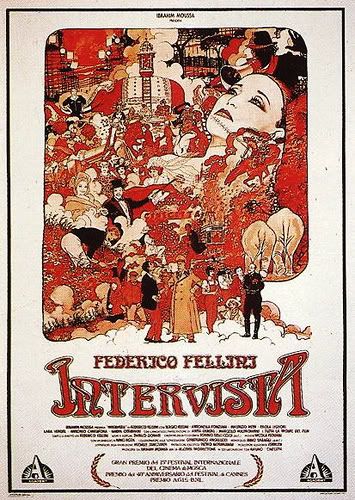
He started with neo realism in the 1940’s. In the 60s and 70s, his films would mold into his signature style: one of dream like states told in an episodic fashion. In his second to last film, Intervista, 1987, Federico Fellini looks back. Much like his earlier film 8 ½, Intervista, gives a back stage pass to the film making process.
However, this time Fellini stars as him self. A trio of Japanese journalist, shooting a documentary, follows Fellini, asking him questions while live on set. The journalists learn Fellini is directing an adaptation of Franz Kafka’s Amerika—the story based on Fellini’s first visit to a movie studio called The Cinecitta.
The story line cuts intermittently between the trio following Fellini and his crew, as they face the obstacles of filmmaking, and the story of young Fellini’s first day at The Cinecitta. Younger Fellini, played by Sergio Rubini, hops on a bus, heading to the movie studio. Humorously, the older and wiser Fellini watches Rubini traverse the world of his distant past.
Cameramen angle their lenses through the windows; the bus picks up speed, and the story begins, as if the cameras where never there. When wild elephants and Native American’s spring from the Italian countryside, it’s apparent: we’re watching a Fellini Film. As a habit, while viewing Fellini’s films, I watch for symbols, representing America. (Reading or understanding Kafka’s play may prove handy in understanding this film.) Most of his films seem like an inside joke or arcane knowledge about the filmmaker. Intervista is rich in references to Fellini’s career, and fans of Fellini are definitely in for a surprise.
Many consider Intervisita to be Fellini's late masterpiece.I honestly don’t know the criteria for this honor, or do I fully understand the significance of this film—I was two years old when it debuted. Still I think Intervista is wonderful closure to a life of film making. It is a celebration of the craft and the energy placed into a successful production. Fellini acknowledged everyone that contributes to production's success: the actors, the crew, and the cinematographer. I especially enjoyed seeing the lighting equipment. Though, I understand the importance of light, seeing this large-scale production, and the massive lights used for an entire dark street, put my rinky dink projects in perspective. I dare not ruin this film, but it’s must watch for people interested in film making and fans of Fellini.
No comments:
Post a Comment